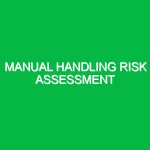In the demanding world of manual labor, the importance of stretching exercises cannot be overstated. These exercises serve as a vital tool for preventing injuries, improving flexibility, and boosting overall productivity. As we delve into the realm of stretching exercises for manual workers, we’ll explore their relevance in the Health, Safety, and Environment (HSE) domain, the hazards associated with manual labor, and the best practices for safe stretching techniques.
Understanding Stretching Exercises for Manual Workers
Stretching exercises for manual workers involve routines specifically designed to enhance muscle flexibility and joint mobility. These exercises can be performed before, during, or after shifts to combat the physical strain associated with repetitive tasks, heavy lifting, and awkward postures. The benefits of incorporating stretching into the workday are profound, ranging from injury prevention to improved mental focus.
Consider the story of Jake, a construction worker with over a decade of experience. After years of ignoring his body’s signals, he suffered from severe back pain that sidelined him for weeks. Upon returning to work, he decided to integrate stretching exercises into his daily routine. Not only did he notice a remarkable reduction in his discomfort, but he also found that he was able to work more efficiently. Jake’s experience illustrates the transformative power of stretching for manual workers.
Potential Hazards and Risks Associated with Stretching in Manual Work Environments
While stretching can offer significant benefits, it is crucial to recognize potential hazards and risks, particularly if not performed correctly. Some common hazards include:
1. Musculoskeletal Injuries
Improper stretching can lead to strains and sprains, particularly in the back, shoulders, and legs. For example, a worker who rushes through stretches or uses improper techniques may inadvertently cause injury. Moreover, static stretches held for too long without a proper warm-up can lead to muscle tears.
2. Overstretching
Overstretching occurs when a worker pushes their body beyond its limits. This can lead to muscle damage and increased recovery time. For instance, a warehouse worker attempting to reach for an item overhead while stretching may overstretch their shoulders, resulting in a painful injury.
3. Slips and Falls
Stretching in an inappropriate setting, such as on a slippery surface, can lead to falls. Imagine a scenario where a laborer stretches on a wet floor without proper footwear—this not only increases the risk of injury but also disrupts workplace safety protocols.
Safety Precautions and Best Practices for Stretching Exercises
To maximize the benefits of stretching while minimizing risks, manual workers should adhere to the following safety precautions:
1. Warm Up Before Stretching
A proper warm-up is essential. Engage in light aerobic activity for 5-10 minutes before stretching. This could be as simple as brisk walking or marching in place. Warming up increases blood flow to the muscles, making them more pliable and less prone to injury.
2. Focus on Proper Technique
Always prioritize correct form over intensity. For instance, when stretching the hamstrings, avoid bending at the waist—this can strain the back. Instead, sit on the floor with one leg extended and the other bent, reaching towards your toes while keeping your back straight.
3. Listen to Your Body
Every worker’s body is unique. It’s vital to listen to its signals. If a stretch causes pain, stop immediately. As Alice, a factory worker, discovered, ignoring discomfort led her to exacerbate a minor issue into a significant injury.
4. Limit the Duration of Stretches
Hold each stretch for 15-30 seconds, no longer. This duration is often sufficient to promote flexibility without risking overstretching. Focus on breathing deeply during each stretch, which can help you relax and improve the effectiveness of the exercise.
5. Incorporate Dynamic Stretching
Incorporating dynamic stretches, which involve movement, can be particularly beneficial before physically demanding tasks. For example, arm circles and leg swings activate the muscles while preparing them for action. A construction site supervisor reported that workers who engaged in dynamic stretching had fewer injuries during heavy lifting tasks.
6. Create a Stretching Routine
Establishing a routine can help workers remember to stretch. Integrate stretching sessions into daily schedules or during breaks. Consider forming small groups for stretching exercises, which can enhance team bonding and accountability.
Regulations and Standards Governing Stretching Exercises for Manual Workers
Various regulations govern workplace safety and health, including stretching exercises for manual workers. The following standards are particularly relevant:
1. Occupational Safety and Health Administration (OSHA) Regulations
OSHA provides guidelines aimed at ensuring workplace safety. While it does not mandate specific stretching exercises, it emphasizes the importance of ergonomics and injury prevention programs in workplaces. These programs often include stretching as a preventive measure against musculoskeletal disorders.
2. National Institute for Occupational Safety and Health (NIOSH) Recommendations
NIOSH has developed resources advocating for stretching and warm-up exercises as part of comprehensive workplace health strategies. Their guidelines encourage employers to implement ergonomics training that includes stretching techniques tailored to specific job tasks.
3. American National Standards Institute (ANSI) Ergonomics Standards
ANSI has established standards that promote ergonomic practices in the workplace. These standards often include recommendations for stretching as part of an overall strategy to reduce the risk of injury related to manual labor.
The Role of Employers in Promoting Stretching Exercises
Employers play a crucial role in fostering a culture of health and safety through stretching exercises. By providing resources, training, and time for stretching, businesses can significantly reduce the risk of injuries. For instance, companies can offer stretching workshops led by professionals or create designated areas for stretching before shifts.
Take, for example, a manufacturing company that implemented a 10-minute stretching session at the beginning of each shift. The initiative not only improved workers’ flexibility but also enhanced morale and productivity. Workers reported feeling more energized and prepared for the day ahead, demonstrating that proactive measures yield positive outcomes.
Conclusion: The Importance of Stretching Exercises in the Manual Workforce
Stretching exercises for manual workers serve as a crucial aspect of health, safety, and environmental management. By understanding the potential hazards associated with manual labor and implementing proper stretching techniques, workers can significantly reduce the risk of injury. The integration of stretching into daily routines not only enhances physical well-being but also fosters a culture of safety within the workplace.
As we’ve seen through real-life examples and recommended practices, the benefits of stretching extend far beyond physical health. They contribute to a more productive, engaged, and satisfied workforce. For manual workers, embracing stretching exercises is not just a personal choice; it’s a commitment to their health and safety on the job.


